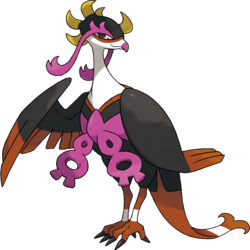From Bulbapedia, the community-driven Pokémon encyclopedia.
|
|
| Line 133: |
Line 133: |
| ==Related articles== | | ==Related articles== |
| * [[The Hidden Treasure of Area Zero]] | | * [[The Hidden Treasure of Area Zero]] |
| | * [[The Teal Mask]] |
| | * [[Kitakami]] |
|
| |
|
| ==Notes== | | ==Notes== |
Revision as of 05:03, 28 February 2023

|
The subject of this article is a Pokémon which has recently been announced.
This article's contents will change as more information becomes available, perhaps abruptly. Please be cautious when adding information to this article, as rumors and speculation can often be confused with facts. Avoid any information on this subject which is not confirmed by reliable sources.
|
Fezandipiti (Japanese: キチキギス Kichikigisu) is a Pokémon introduced in Generation IX.
It is not known to evolve into or from any other Pokémon.
Biology
Fezandipiti, together with Okidogi and Munkidori, are known as The Heroes of Kitakami. They are beloved by the people of Kitakami as heroes that protected the land in the past, and stone statues were made in their likeness to express the people’s gratitude toward these three Pokémon.[1]
Trivia
Origin
Fezandipiti may be based on a pheasant.
Fezandipiti, together with Okidogi, Munkidori, and Ogerpon, may reference the Japanese folktale of Momotarō. The tale relates the titular Momotarō, a boy born from inside a peach, who traveled alongside a talking dog, monkey, and pheasant to fight a band of oni (a Japanese folkloric creature commonly equated to ogres in translations).
Name origin
Fezandipiti may be a combination of pheasant and serendipity (an unexpected but auspicious happening).
Kichikigisu may be a combination of 吉 kichi (fortune) and 雉子 kigisu (archaic reading of pheasant).
In other languages
| Language
|
Title
|
Meaning
|
 Japanese Japanese
|
キチキギス Kichikigisu
|
From 吉 kichi and 雉子 kigisu
|
 French French
|
Favianos
|
From faveur, avian, and phasianos
|
 Spanish Spanish
|
Fezandipiti
|
Same as English name
|
 German German
|
Beatori
|
From beatus and 鳥 tori
|
 Italian Italian
|
Fezandipiti
|
Same as English name
|
 Korean Korean
|
기로치 Girochi
|
From 길하다 gilhada, 그렇지 geureohji, and 치 (雉) chi
|
 Mandarin Chinese Mandarin Chinese
|
吉雉雞 / 吉雉鸡 Jízhìjī
|
From 吉 jí and 雉雞 / 雉鸡 zhìjī
|
 Cantonese Chinese Cantonese Chinese
|
吉雉雞 Gātjihgāi
|
From 吉 gāt and 雉雞 jihgāi
|
|
|
|
|
|
|
|
Related articles
Notes
External links

|
This Pokémon article is part of Project Pokédex, a Bulbapedia project that aims to write comprehensive articles on each Pokémon species, as well as Pokémon groups and forms.
|


